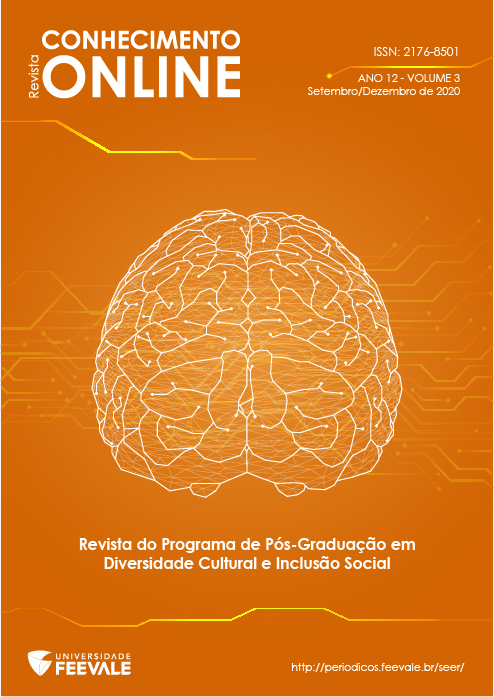SOB LENTES DO MULTILETRAMENTO: LEITURA E COMPREENSÃO DE SENTIDOS EM TEXTOS DE GÊNEROS MULTIMODAIS
DOI:
https://doi.org/10.25112/rco.v3i0.1878Abstract
RESUMO
As transformações estruturais pelas quais a linguagem e a comunicação têm passado revelam o dinamismo e a plasticidade característicos de ambas. Ao mesmo tempo em que essas reestruturações são em parte decorrentes dos avanços tecnológicos, cada vez mais voláteis e promissores, elas os subsidiam, estabelecendo-se uma relação recíproca e produtora de novos gêneros discursivos. Estes, por sua vez, instauram circunstâncias enunciativas híbridas tanto em termos composicionais como semânticos, veiculando textos multimodais e reivindicando, em consequência, práticas multiletradas. Diante desse panorama, este estudo justifica sua importância pela atenção que dá às novas configurações de leitura que emergem em um contexto hipermidiático crescente. A partir disso, propõe-se como objetivo refletir sobre práticas de leitura e compreensão de sentidos em textos de gêneros multimodais realizadas pelo sujeito-leitor que exigem, além do letramento, um olhar multiletrado para o objeto, para o mundo. Neste estudo, utilizam-se as contribuições de Bakhtin (2011), Dionisio (2011), Lemke (2010) e Rojo e Barbosa (2015). Por meio de pesquisa qualitativa e bibliográfica, é feita análise de corpus representado por um trailer de uma série de entretenimento, revelando a importância da reflexão acerca das multissemioses e da percepção, nessas, das hibridizações entre os diferentes gêneros discursivos que, dialogicamente, são responsáveis pela construção do sentido de um texto. Finalmente, espera-se, com este trabalho, contribuir com as questões que se voltem às metodologias de ensino empregadas especialmente na educação básica, em que o ensino-aprendizagem, para não se tornar arbitrário, precisa reconhecer que a formação discursiva do aluno, hoje, é pautada no prefixo multi: redes multimídia, textos multimodais, percepções multiculturais, olhares multifocais.
Palavras-chave: Ensino. Gêneros Discursivos. Gêneros Multimodais. Multiletramento.
ABSTRACT
The structural transformations through which language and communication have passed reveal the dynamism and plasticity characteristic of both. At the same time that these restructurings are partly due to technological advances, which are increasingly volatile and promising, they subsidize them by establishing a reciprocal relationship and producing new discursive genres. These, in turn, establish hybrid enunciative circumstances in both compositional and semantic terms, conveying multimodal texts and claiming, as a consequence, practices of multiliteracy. In face of that, this study justifies its importance by its focus on the new reading forms, which emerge in a growing hypermedia context. The objective of this study is to reflect on reading practices and comprehension of meanings in texts of multimodal genres, what requires from the reader, besides literacy, multiliteracy to read the world. This research is based on contributions of Bakhtin (2011), Dionisio (2011), Lemke (2010) and Rojo and Barbosa (2015). Through a qualitative and bibliographical research, an analysis of a TV series trailer shows the importance of the reflection about the multisemiosis and the perception, in these, of hybridizations between different discursive genres that, dialogically, are responsible for construction of the meaning of a text. Finally, this research intends to contribute with the issues about teaching methodologies that are used especially in elementary and high school, in which the relation teaching-learning, in order not to become arbitrary, must recognize that the discursive formation of a student is based on the prefix multi nowadays: multimedia networks, multimodal texts, multicultural perceptions, multifocal perspectives.
Keywords: Teaching. Discursive Genres. Multimodal Genres. Multiliteracy.
Published
How to Cite
Issue
Section
License
• Os autores mantêm os direitos autorais e concedem à revista o direito de primeira publicação com o trabalho licenciado sob a Licença Creative Commons - Attribution 4.0 International (CC BY 4.0).
• Os autores são estimulados a publicar e distribuir seu trabalho online (ex.: em repositórios institucionais ou na sua página pessoal), pois isso pode aumentar o impacto e a citação do trabalho publicado.


